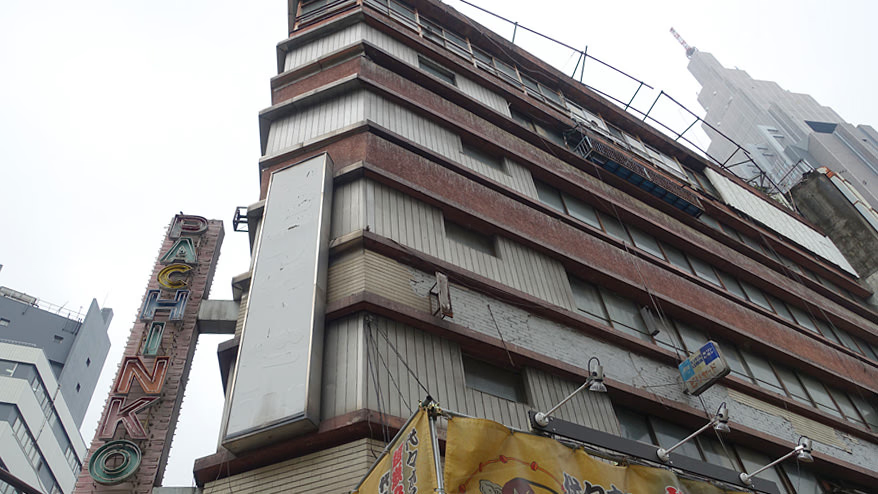Do you know the semi-abandoned building that stands in front of Yoyogi Station?
Yoyogi Kaikan is a building that still exists in the big city of Tokyo , and it feels as if you have traveled back in time to the Showa era. It is a building that has been left behind by modern times , and the shops that surround it retain a Showa-era atmosphere.
In this edition of the Yoyogi Backstreets Walking Map, we will introduce you to some little-known spots in front of Yoyogi Station that seem to have been left behind by the Heisei era.
Sneaking into Yoyogi Kaikan, rumored to be the Kowloon City of Yoyogi

Yoyogi Kaikan, now semi-ruined
This is Yoyogi Kaikan. As you can see, there are no windows on the upper floors, and rust is visible on the signs and walls.
Only the signs remain, and most of the stores are closed.
According to the real estate agent's information, it was built in 1969. That would make it 47 years old, but it looks like it's older than that. According to rumors on the Internet, many people believe it was built around 1945-1955.
Also, due to its appearance, it has been nicknamed Yoyogi's Kowloon City, and is actually popular among ruins enthusiasts.
It seems that the building previously housed the popular local diner " Shinobu " and the notorious "Nikomiya Narita," which is known for being difficult to get reservations for.
It was also used as a filming location for the TV drama "Scarred Angel" which aired in 1974, and since the main character lived in a penthouse on the rooftop, it was sometimes called Angel Building.
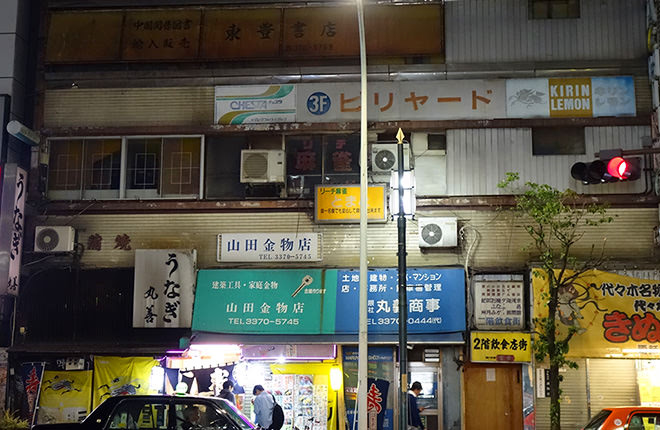
Yoyogi Kaikan at night. The sushi stand and Kinuchan Diner are open for business, making the place lively. The sushi stand has been replaced by the Yamada Hardware Store sign, creating a strange, chaotic atmosphere.
So let's dive right in.
The only stores currently open in Yoyogi Kaikan are Toho Bookstore, which imports and resells books related to China, Kinuchan Shokudo, and a stand-up sushi restaurant that appears to be extremely cheap.
At night, the first floor is lively, creating a striking contrast with the ruined feel of the upper floors.

Is there anyone who would look at this photo and think it's a photo of modern-day Tokyo?
Climb the stairs at the entrance where there is a large sign that says "2nd Floor Food and Drink District."
On the landing of the stairs, the signs of shops that must have once flourished are lined up, looking desolate. There is graffiti everywhere, giving the place a truly decadent atmosphere.
Feeling a little disheartened, I pull myself together and head to Toyo Bookstore on the third floor.
On the landing at the front of the third floor, there is a row of books that appear to be in stock.
When I spoke to the owner of the bookstore, he said that he would talk about books, but didn't want to talk about the building. Many people interested in the building had visited the bookstore in the past, and it must have been a hassle for the owner.
Furthermore, the building is dilapidated and dangerous and entry is prohibited from the fourth floor and above, so we were unable to investigate any floors above that.
Considering that it has been abandoned without any windows, it's a little scary to imagine what it must be like inside.
A "Showa"-style pork cutlet restaurant in front of Yoyogi Station
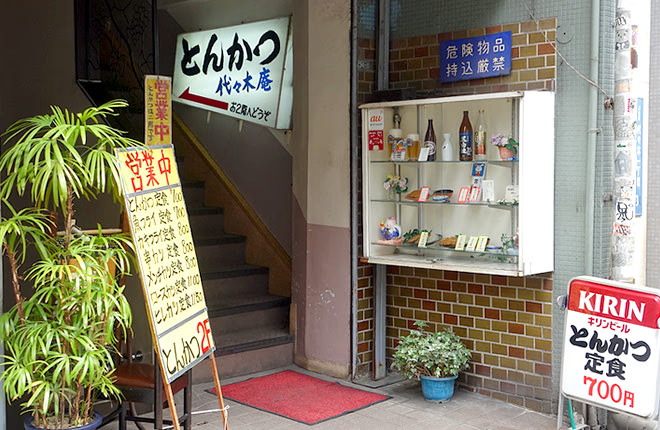
Overlooking Yoyogi-an in front of Yoyogi Station
Since we couldn't hope to investigate Yoyogi Kaikan any further, we decided to sneak into Yoyogi-an, a pork cutlet restaurant located in the equally old building next door.
The same building used to house a soba restaurant called "Yoyogi-an," but it has since closed. There is also an izakaya called "Yoyogi-an" in the basement, which is run by the brothers of the tonkatsu restaurant. It's interesting that all the stores are operating under the same name.
The samples displayed in the glass case in front of the stairs leading up to the tonkatsu restaurant and the red lanterns lined up in the windows create an indescribable Showa-era atmosphere.
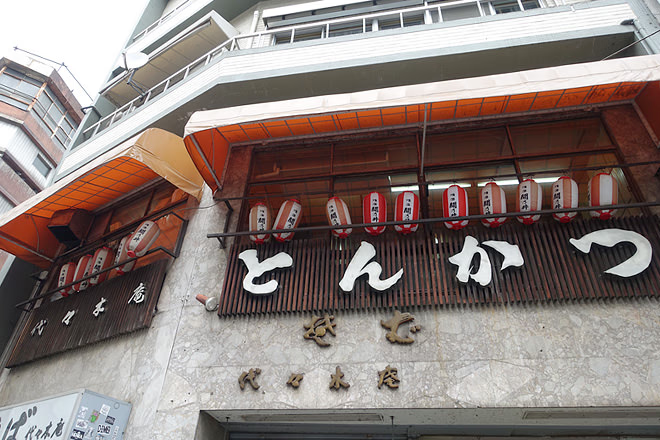
The windows lined with red lanterns have a certain charm

Nostalgic food samples
When you enter the restaurant, the opposite side is a large kitchen where three men and women are working efficiently and efficiently. When I talked to the employees, I learned that they have worked together for a long time and now have a family-like relationship, and I was impressed by the excellent teamwork of the three.

It's rare to see such a large kitchen. It looks like it will be easy to use.
The walls are covered with a long menu, giving the place an atmosphere of a nostalgic bar from the Showa era. The menu includes items such as fried red sausages and chikuwa cheese, which are great for beer. Looking at the menu, you'll find yourself wanting to have a beer as a snack in the afternoon.
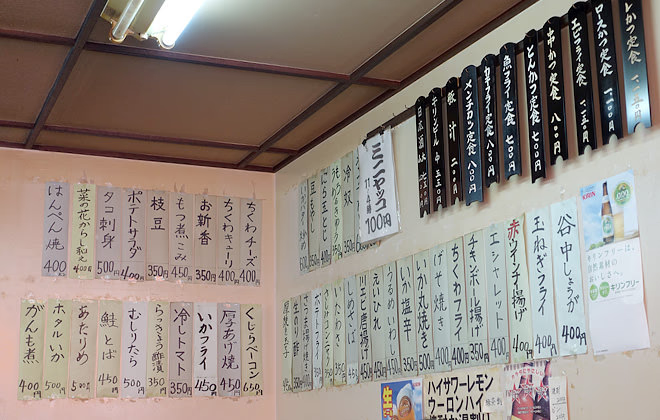
The wall is covered with a menu of short strips of home-cooked cuisine.
As I was thinking this, I spotted a man in a suit having a beer as a snack in the afternoon.
It's a mystery what the circumstances are behind this, but it's a place that seems particularly fitting for salarymen drinking beer in the afternoon.

I'm jealous of the snacks to go with your beer. And two of them!
Now, let's eat the important part: the pork cutlet set meal.
The set meal includes pork cutlet, thick shredded cabbage, rice, pickles, and miso soup.
For the price of 700 yen, it was a big cutlet, and the meat was well-balanced, not too thick or too thin. It tasted like a proper tonkatsu restaurant, not like a cheap set meal restaurant.
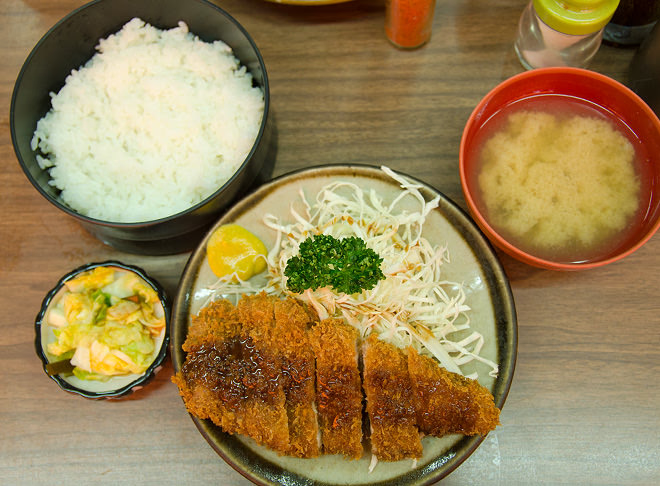
The menu includes a large pork cutlet, thick cabbage, rice, miso soup, and pickles.
The rice is fluffy and cooked just right, and the light pickles help refresh your mouth after eating the oily pork cutlet.
Overall, there is nothing particularly special about the food, but it has a comforting taste. It's a restaurant that you'll remember and want to visit when you suddenly feel like eating pork cutlet.

A charming mother with a perfect pose
According to the owner of the shop, the shop has been in business since the time of the Tokyo Olympics in 1964, so it has been around for over 50 years since it was founded.
There are some Monosus employees who are fans of the atmosphere of this store, so I hope it will continue to do well as a rare spot that preserves Yoyogi's Showa era atmosphere.
This concludes our stroll around the Showa era in front of Yoyogi Station.
Next time, I would like to introduce some deep and unique shops in the Yoyogi area again.
Tonkatsu Yoyogi-an
Watanabe Building 2F, 1-34-5 Yoyogi, Shibuya-ku, Tokyo
TEL: 03-3379-5094
Business hours: 11:00-21:30
Closed: Sundays and public holidays
